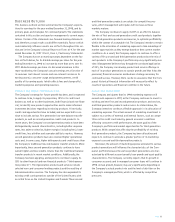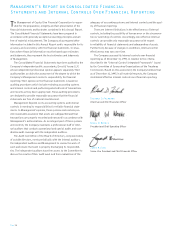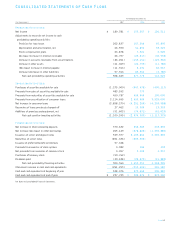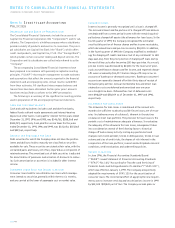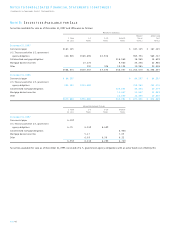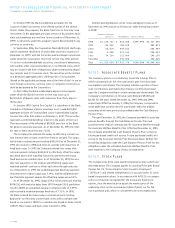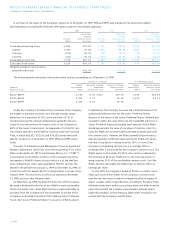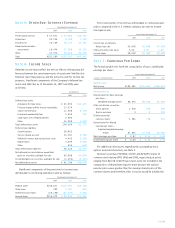Capital One 1997 Annual Report Download - page 46
Download and view the complete annual report
Please find page 46 of the 1997 Capital One annual report below. You can navigate through the pages in the report by either clicking on the pages listed below, or by using the keyword search tool below to find specific information within the annual report.Notes to Consolidated Financial Statements
(Currencies in Thousands, Except Per Share Data)
Note A: Significant Accounting
Policies
Organization and Basis of Presentation
The Consolidated Financial Statements include the accounts of
Capital One Financial Corporation (the “Corporation”) and its sub-
sidiaries.The Corporation is a holding company whose subsidiaries
provide a variety of products and services to consumers.The princi-
pal subsidiaries are Capital One Bank (the “Bank”), which offers
credit card products, and Capital One, F.S.B. (the “Savings Bank”),
which provides certain consumer lending and deposit services.The
Corporation and its subsidiaries are collectively referred to as the
“Company.”
The accompanying Consolidated Financial Statements have
been prepared in accordance with generally accepted accounting
principles (“GAAP”) that require management to make estimates
and assumptions that affect the amounts reported in the financial
statements and accompanying notes. Actual results could differ
from these estimates. All significant intercompany balances and
transactions have been eliminated. Certain prior years’ amounts
have been reclassified to conform to the 1997 presentation.
The following is a summary of the significant accounting policies
used in preparation of the accompanying financial statements.
Cash and Cash Equivalents
Cash and cash equivalents includes cash and due from banks,
federal funds sold and resale agreements and interest-bearing
deposits at other banks. Cash paid for interest for the years ended
December 31, 1997, 1996 and 1995, was $346,761, $288,568 and
$184,729, respectively. Cash paid for income taxes for the years
ended December 31, 1997, 1996 and 1995, was $131,052, $107,065
and $82,561, respectively.
Securities Available for Sale
Debt securities for which the Company does not have the positive
intent and ability to hold to maturity are classified as securities
available for sale.These securities are stated at fair value, with the
unrealized gains and losses, net of tax, reported as a component of
retained earnings.The amortized cost of debt securities is adjusted
for amortization of premiums and accretion of discounts to matur-
ity. Such amortization or accretion is included in other interest
income.
Consumer Loans Held for Securitization
Consumer loans held for securitization are loans which manage-
ment intends to securitize, generally within three to six months,
and are carried at the lower of aggregate cost or market value.
Consumer Loans
Interest income is generally recognized until a loan is charged off.
The accrued interest and fee portions of a charged off loan balance
are deducted from current period income with the remaining princi-
pal balance charged off against the allowance for loan losses. In the
fourth quarter of 1997, the Company recognized the estimated
uncollectible portion of finance charge and fee income receivables,
which decreased loans and pre-tax income by $50,200. In addition,
in the fourth quarter of 1997, the Company modified its methodol-
ogy for charging off credit card loans (net of any collateral) to 180
days past-due, from the prior practice of charging off loans during
the next billing cycle after becoming 180 days past-due. As a result,
pre-tax income was decreased by $23,141 for the reversal of previ-
ously accrued finance charges and fee income, and reported charge-
offs were increased by $11,477. Earlier charge-offs may occur on
accounts of bankrupt or deceased consumers. Bankrupt consumers’
accounts are generally charged off within thirty days of receipt of
the bankruptcy petition. Annual membership fees and direct loan
origination costs are deferred and amortized over one year
on a straight-line basis. Deferred fees (net of deferred costs)
were $98,619 and $58,059 as of December 31, 1997 and 1996,
respectively.
Allowance for Loan Losses
The allowance for loan losses is maintained at the amount esti-
mated to be sufficient to absorb possible future losses, net of recov-
eries (including recovery of collateral), inherent in the existing
on-balance sheet loan portfolio.The provision for loan losses is the
periodic cost of maintaining an adequate allowance. In evaluating
the adequacy of the allowance for loan losses, management takes
into consideration several of the following factors: historical
charge-off and recovery activity (noting any particular trend
changes over recent periods); trends in delinquencies; trends in loan
volume and size of credit risks; the degree of risk inherent in the
composition of the loan portfolio; current and anticipated economic
conditions; credit evaluations and underwriting policies.
Securitizations
In June 1996, the Financial Accounting Standards Board
(“FASB”) issued Statement of Financial Accounting Standards
(“SFAS”) No. 125, “Accounting for Transfers and Servicing of
Financial Assets and Extinguishments of Liabilities”(“SFAS 125”),
which was effective January 1, 1997.The Company prospectively
adopted the requirements of SFAS 125 for the securitization of
consumer loans.The incremental effect of applying the new require-
ments, was to increase servicing and securitizations income in 1997
by $32,000 ($19,840, net of tax).The Company records gains or
PAGE 44



